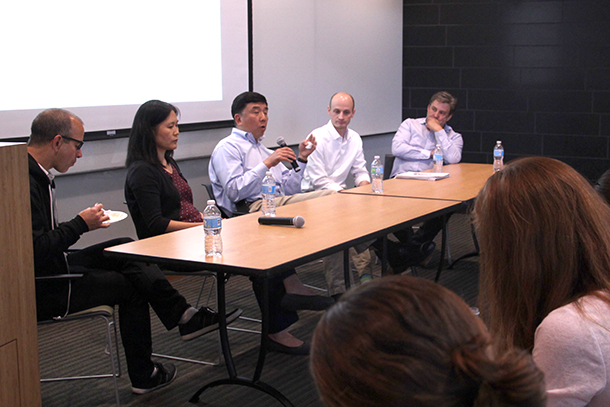“I think we’re all here for the same reason,” said Michaela Patterson, PhD, a postdoc in the Eli and Edythe Broad Center for Regenerative Medicine and Stem Cell Research at USC. “We’re considering applying for faculty jobs, and we’re at a loss for where to start.”
To prepare themselves for the rigors of the application process, nearly 50 postdocs came from departments across USC to attend the first installment of “Preparing for the faculty job market.”
The three-part seminar series is the brainchild of USC Stem Cell postdocs Patterson and Lindsey Barske, PhD. The two secured funding for the series from USC’s Center for Excellence in Research, as well as the participation of both junior and senior faculty from the Department of Stem Cell Biology and Regenerative Medicine at the Keck School of Medicine of USC.
The kick-off seminar focused on how to structure the research statement, an essential component of the faculty application package. Gage Crump, PhD, associate professor of stem cell biology and regenerative medicine, delivered a pithy and practical 15-minute lecture on the subject.
“The number one tip is know your audience,” he said. “The people reviewing your research statements are generally faculty that are going to likely have other deadlines — papers and grants and whatever. And so it’s really important that you make it concise and easy-to-read. If they see some really dense, wordy research statement, they’re less likely to read it at all.”
Crump then joined several of his colleagues — Yang Chai, DDS, PhD, professor and associate dean for research at the Herman Ostrow School of Dentistry of USC; Denis Evseenko, MD, PhD, associate professor of orthopaedic surgery; Joseph T. Rodgers, PhD, assistant professor of stem cell biology and regenerative medicine; and Min Yu, MD, PhD, assistant professor of stem cell biology and regenerative medicine — on a panel that fielded questions from the eager and slightly anxious audience.
Some questions focused on the research statement: How many research projects should you include in the statement? (Answer: three) Do you start with the most significant project or the most recent? (Answer: most significant)
The discussion also veered into more nuanced questions of strategy: How do you know when you’re ready to apply for faculty positions? How do you differentiate yourself from your faculty mentor? Is it worth considering non-tenure-track faculty positions?
At the conclusion of the seminar, Chai graciously added, “I’ll say on behalf of the panel, you all know where we are. Just email us or come over to our offices. We can talk.”
In the second seminar on July 21, Leonardo Morsut, PhD, assistant professor of stem cell biology and regenerative medicine, will continue the mentorship series by addressing the remaining application documents, including the CV, cover letter, teaching statement and diversity statement. Morsut’s colleagues — Neil Segil, PhD, professor of research stem cell and regenerative medicine; Megan McCain, PhD, assistant professor of biomedical engineering; and Senta Georgia, PhD, assistant professor of pediatrics — will join him for the panel discussion about other key aspects of the application process, such as how to search for jobs and how to select who writes letters of recommendation.
The third seminar, to be held in November, will conclude the series with an overview of the interview process, including the infamous “job talk” and “chalk talk.”
“The goal,” Barske said, “is to help our fellow postdocs present themselves effectively as attractive candidates on the highly competitive academic job market.”
— Cristy Lytal


